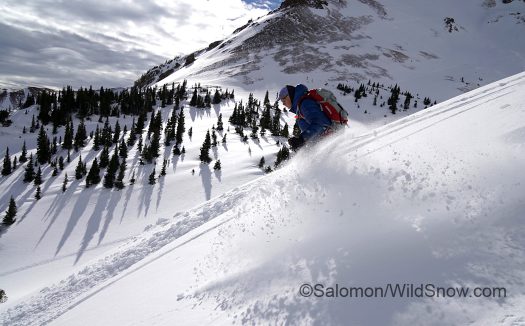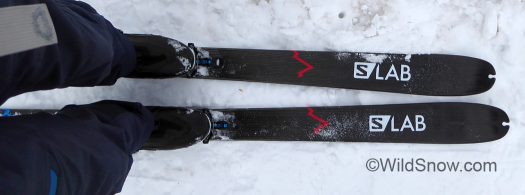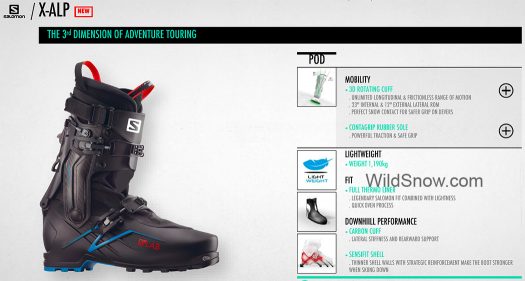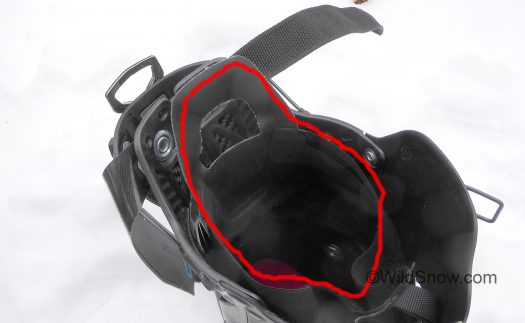For binding specifications and more details, please check our Salomon-Atomic binding FAQ.
Mouth breathing gear bloggers unite! Always funny to put all this energy into checking out new gear — kit that won’t be available for about a year. But hey, it’s a job, and I know some of you enjoy seeing what’s speeding (or crawling) down the road to retail.
Objects at hand: Salomon announces their new “X-Alp” ski touring lineup, comprising a skinny yet sweet skiing 80 mm plank, efficient boot, and impressive tech binding. Everything is high tech and low weight, with the X-Alp ski coming in as a true 1-kilo wonder, boot just over a kilo, and the MTN binding holding its own with any other lightweight tech offering (300 grams without available brake, one binding, note this is the same binding as Atomic Backland, different color and branding). The brake is probably the news, it operates independent of the heel unit, by manually flipping a lever that stows the brake arms for touring. Brake will be available in 80, 90, 100, 110 and 120 mm widths.
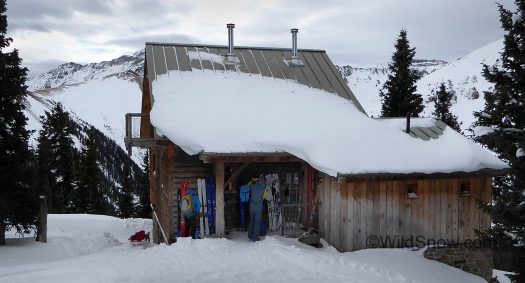
I love it when companies touting their backcountry skiing gear actually host their press events in the backcountry. In this case, our crew of Salomon associated folks and scribble hacks like me was hosted by the premium full-service Opus hut. Super. I won’t get into Opus details here — we need another blog post for that — but suffice it to say that European style hut touring is here in the Rocky Mountains, and we highly recommend.
The boot is of course quite similar to the Arcteryx Procline so you can refer to those reviews as deep background. Binding is similar to the Atomic Backland we extensively tested and reviewed last season, with a a nicely engineered optional brake and innovative heel unit.
As for the X-Alp 80 mm ski, I stepped up my game and skied it 2 of my 4 days on the Salomon gear as it’s the only ski officially in the X-Alp product category. I was mystified as to why the other two pair of X-Alp toothpicks remained leaning against the hut while other product testers laughed as they rode a variety of Salomon wide boards. Perhaps they knew something I did not? Perhaps they were laughing, at, me?
Not sure the X-Alp needs a WildSnow “real” review yet since I didn’t use it on hard snow (and I doubt this is the retail version), but honestly, I had a lot of fun working these skinnys in the San Juan pow, as they’re supple enough to snake as many turns as you want. (Though trying to ski like it was 1979 wore me out, compared to slarving a wide body and relaxing). Verdict: I want a pair for my quiver, both for fitness uphilling and springtime peak descents.
X-Alp ski. 164 cm, radius 17 m, 113-79-99. Could this be a throwback trend? Reminded me of the Black Diamond Mira, only lighter at 980 grams for this pair. Also noted, I’m told they also have a ski (now available) developed specifically for Kilian Jornet, S Lab Minim, 68.5 mm waist, 740 grams, super stiff for the crazy downhill racing they do in rando ski competitions.
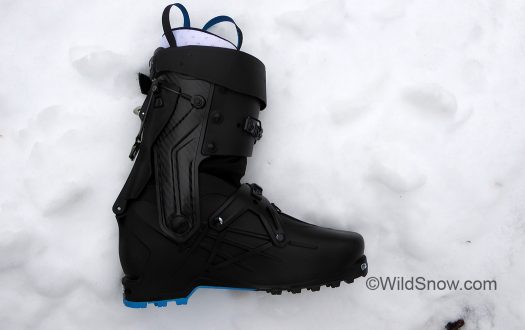
Our very own samples of the Salomon X-Alp boot. One of the only few size 28 was air shipped from eastern Europe specifically so yours truly could ski them. Humbling. Luckily they skied quite well. Otherwise the guilt would be devastating. Instead, I can say “tally ho!” we have a winner. Yes, Virginia, somewhat similar to Arcteryx Procline in that they used same or similar molds and the excellent lean lock system allowing “rolling” ankle travel in touring mode. But the cloning ends there. Read on.
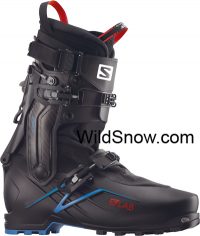
Here is how X-Alp will appear in retail, nicely accented, with unassuming branding. Way better than you being an unpaid banner ad. Click to enlarge.
Salomon did a no-brainer here. They took the Arcteryx Procline form factor (the two companies are entwined) and presumably the same mold tooling, and made a full-on ski touring boot. In case you don’t remember, what’s unique to Procline is a lean lock machine that when released for uphill mode allows rolling flexion of the ankle. Result, better ergonomics in your ski touring strides. Resembles wearing hiking boots or the like.
But Procline is a “hybrid” boot that’s designed for alpine climbers who need to ski. Beefy sole and rubber rand around the toe mark the difference. X-Alp gets rid of the extras for that magical ~1-kilo weight target. Again, X-Alp is a ski touring boot, pure, simple, effective.
More: they reinforced the X-Alp shell around the cuff pivot, for less bulge and stronger feel in downhill mode. Built-in gaiter is shorter and simplified. Sole is lower density to save weight (and said to be better on ice, Procline designed for peak scrambling on mixed ground). Instep buckle is cleaned from Procline cable weave to a single clasp (we like Procline system better).
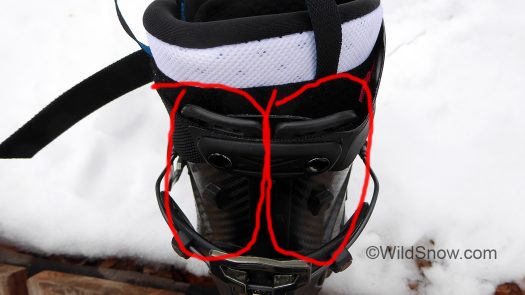
Split cuff is worthy of Einstein mentality, same action as Procline. A sort of “parallelogram” effect working off the power strap rivets gives you impressive rolling ankle flexion that’s (somewhat) capable of modern waterfall ice climbing.
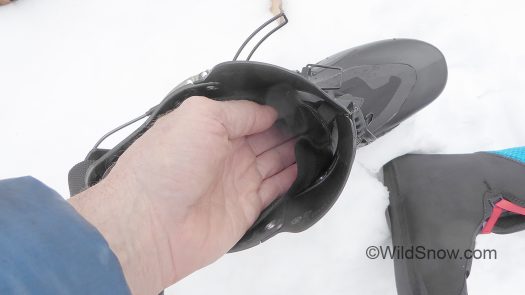
X-Alp internal gaiter is shorter and doesn’t have a front zipper such as Procline. Myself and others found that entering and exiting X-Alp was somewhat more difficult than conventional tongue boots or the zippered Procline. We’re not sure what the solution for that is, but in my opinion if they simply added a centimeter or two of extra slack in the gaiter, over instep, the boot would be easier to work. That said, the liner has a nice lacing system (see below), but loosening the laces sometimes doesn’t translate down to your instep and fools you into thinking something is going on with the shell when it’s actually the liner.
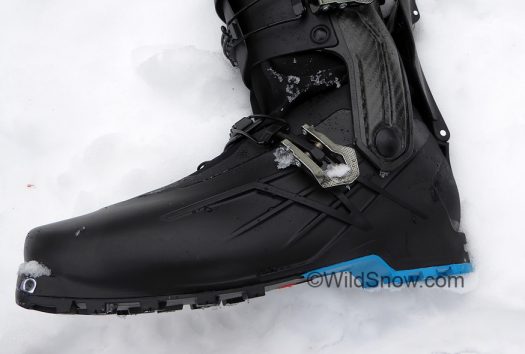
Sides near cuff pivot are stiffened with additional plastic exoskeleton molded in. I’m disappointed with this instep buckle location. Nearly guaranteed it’ll open up during extreme maneuvers or post holing. Procline is better in this regard as it locates the buckle on top of your instep, out of the way. Word from on high is that buckles that close directly over your instep somehow produce more uncomfortable pressure than those that close to the side. In my view, that’s an engineering and boot fitting problem, not an inviolate principle of physics, and can thus be dealt with. Truth, I was surprised to see this buckle location. I guess the Salomon boot designers have never rappelled with a boot that opened in the middle of a 50 meter cliff.
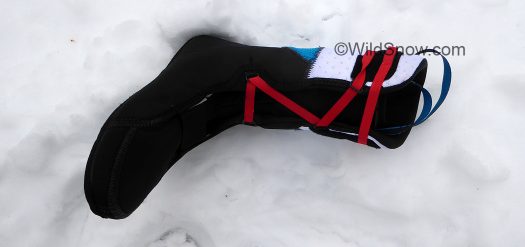
Zee liner, is, zee liner. Mostly standard stuff. Same type of foam as Intuition (use same forming heat), nice lacing system that pulls tight and wraps around at cuff to hook-loop anchor. Best feature? Soft articulated patch behind your Achilles tendon, yielding less interference with cuff pivot during walking. Any ski shoe that claims to be a ‘touring boot’ needs this feature.
One other thing on the technical side. Salomon claims their formulation of Grilamid plastic is “best ever” for punching. It’s said to “shrink back” the least. My theory with heat punching Grilamid is that thoroughly heating it (by using heated mandrel as well as not blasting with heat gun) as well as leaving on press for at least ten minutes, along with cooling, takes care of noticeable shrinking of the punch. But better plastic, if that’s so, is welcome.
Okay, all that techie pro con yammering aside, how did they ski? Salomon hosted a nice press event to introduce their full X-Alp touring line. We spent a night in Silverton, Colorado listening to the party line and baking liners, then we headed up to what might is clearly the best full-service mountain hut in Colorado and perhaps in the United States. Opus Hutte. More later on that. Thoughts of the moment are yes folks this boot is downright excellent. In classic rando mode I buckled the X-Alp to my downhill settings, then released the cuff latch and toured. Downhill? I simply reached down, snapped the lean lock, and off I went making thousands of turns (if you were there, you understand). Using a boot that way is the end-goal of good design.
Stiffness? No problema. Know that any boot that doesn’t use overlap cuff type construction can actually be made so stiff, it’s too stiff. Trick is tuning flex. Easy to do with overlap. Harder to do with a “tongue” boot such as X-Alp, that depends on spine stiffness and a certain amount of lower cuff bulge to provide more than the feeling of skiing in cement filled buckets.
Honestly, I was pleasantly surprised at the flex of these shoes. I’m a unique tester, in that my left fused ankle needs a boot with quite the strong forward-rear flex stiffness, while my right foot likes a boot with some cuff movement. Bottom line, I could tune X-Alp to either foot and they worked well respectively.
As always, some of you will gently (ever so gently) inquire as to last width. That’s defined in the industry as interior width in millimeters at the widest part of the shell forefoot area, shell size 27. Salomon told me these are a “98” last. Since I have a size 28 shell I can’t get you a “last” number here in the WildSnow studio. But I can say these are not particularly narrow boots, nor are they sloppy. For me, they’re nearly perfect and the size 28 requires only a moderate shell punch at my forefoot. Interestingly, in nearly all other ski boots I need a shell that’s one step below the size 28, to provide a snug shell-fit at my ankle. In the X-Alp a 27 shell was clearly too small, and the ankle area feels perfect with the 28. Thus, it could be said this boot “runs small.” Keep that in mind if you’re evaluating for purchase.
X-Alp Salomon boot weights:
My 28/28.5 shell is BSL 305mm and 1006 grams (no liner)
Liner is 274 grams with stock footbed.
Total weight, my 28/28.5 is thus 1280 grams (45 ounces)
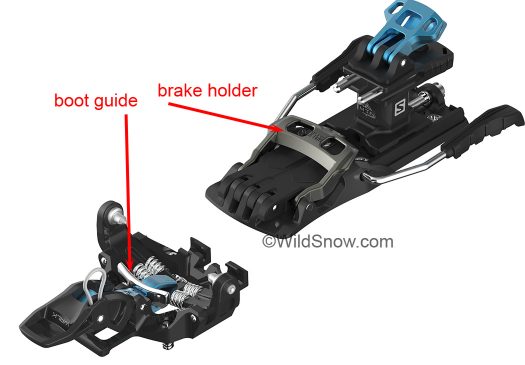
MTN binding is quite similar (or perhaps identical to new model) to Atomic Backland we covered last year. Word inside is they didn’t officially sell this binding in the U.S. last season because it didn’t have an available brake. I’m not sure if that’s the whole story, but at any rate the Salomon MTN version will be available in North America after it goes to retail next fall, while I’d imagine the Atomic Backland version might be available earlier, perhaps even this winter. Perusal of etailers will tell the tale. I’m fascinated by how tightly engineered the heel unit of this binding is. A U-shaped spring is swapped in to create different release tension levels, and the spring provides both rotation and upward (vertical) release rather than two separate springs as with most tech bindings. Even more unique, the spring housing rotates independent of the heel lifters. To be clear, the heel lifters do NOT rotate, they only flip.
Our group of North American gear testers found it quite funny that Salomon is calling their choices in brake spring tension options as “Man, Woman, Expert.” We’ll leave the 57 different gender riffs you can do on that verbiage up to your imagination. It had to be mentioned or I’m not a blogger.
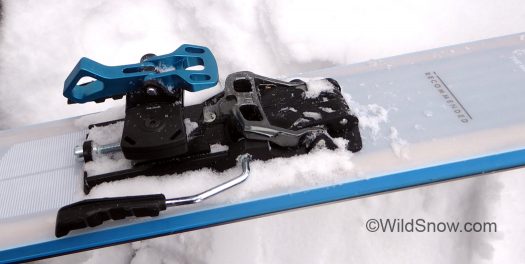
MTN binding with heel unit rotated to heel-flat-on-ski position. Brake is retracted and clipped to upward stowed position by flipping the obvious flange on top of the brake.
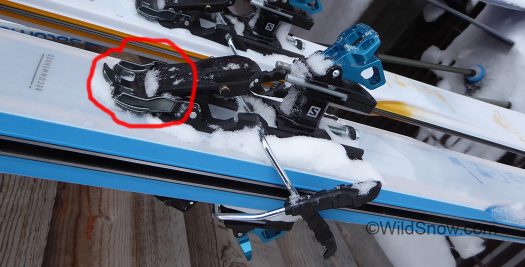
MTN binding with brake deployed for downhill. Clip flange is flipped forward. This “separated” method of brake stowage, as opposed to efforts made by other brands to integrate brake retraction with heel unit, is what I’d like to see all tech binding makers use. Getting fancy with integrated brake retraction systems has been a huge distraction in the industry. Get over it. A vast number of people ski without brakes, anyhow. Indeed, how easily a binding brake can be removed is perhaps the number one brake “feature” on our list. Easy installation is number two. Both features present here.
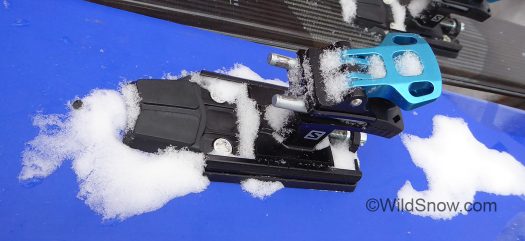
MTN binding configured without brake. As with Atomic version, the screw holes pattern at toe is wide. Heel shown here utilizes the “Expert” heel spring, which is neither male nor female, or so I was told (smile). Boot length adjustment range is 3 centimeters.
Addendum:
This brake design is clever, in that acquiring a ski touring binding TUV certification to DIN/ISO norm requires a brake system that can’t be retracted (stowed) while you are in alpine mode — ostensibly to prevent mistakes or deliberate skiing without a functional brake. I’m told this is the main reason we have the sordid history of tech binding brakes that have gone through multiple problematic iterations. The clever part is this. Salomon simply shaped the holding latch on their brake, when in the uphill (stowed) position, to prevent your being able to click into the heel and use the binding for the downhill. While the Atomic-Salomon Backland-MTN binding is not TUV certified, we suspect the plan might be to use this brake on other projects that might be going for a certification. An insider in Chamonix got me thinking about this, as he’d seen something interesting getting tested.
Official PR, edited for brevity and clarity:
Salomon Unveils New Adventure Touring Product Line
ANNECY, FRANCE — When the products in Salomon’s new adventure ski touring range reach retailers in the fall of 2017, they will already have been tested and validated in some of the planet’s more challenging mountain locations: Le Nant Blanc/La Verte above Chamonix, the Matterhorn, and Mount Everest to name just a few.
The 2017-2018 S/LAB X Alp (WildSnow note, we’re spelling it X-Alp) range of adventure touring products (available fall of 2017) features a new ski boot, ski, and apparel range created specifically for the body movements of touring. Goal is to build future technologies that are lightweight, deliver safety and performance going uphill and down…
In the case of the S/LAB X Alp touring ski boot ($1,000), Salomon athletes took their testing mission to the extreme. Freeride skiers/mountaineers Tony Lamiche and Alex Pittin used their prototype boots to ski La Nan Blanc/La Verte in Chamonix, a face that had been skied just three times in history. On the women’s side, Liv Sansoz climbed and skied the Matterhorn in the S/LAB X Alp boots. And Kilian Jornet took the X Alp boots to Everest and spent his “play” days climbing and skiing on the world’s highest mountain (WildSnow note: anything Kilian uses for playing around on Mount Everest perks our curiosity, even his socks).
X Alp boot features a unique 3D rotating cuff that provides lateral range of motion (WildSnow: what we’d call “ankle roll”), making both skin climbing and working without skis much more ergonomic and downright comfortable. To deliver downhill performance, Salomon engineers used a construction that has been proven in the MTN and QST Pro boot concepts. A carbon cuff-spine for rearward support and adequately stiff Grilamid shell do the job. The S/ LAB X Alp boot is also lightweight. At 1,150kg on each foot (size 27), you won’t be waste energy hauling extra mass.
The S/Lab X Alp Ski (Wild-note: sold with or without Pomoca sourced skins) is designed for adventure touring aficionados who seek a ski with reliability, stability and strength. At 80mm at the waist, it weighs just 980 grams and was developed in close partnership with Kilian Jornet. Layers of carbon, fiberglass and the all-natural flax fiber are positioned in just the right areas to provide superior strength-to-weight ratio and a supple yet supportive flex (WildSnow note: we agree, for this small a plank these ski surprisingly well). The reinforced binding zone has a Titanium insert and a fiber layer on top to deliver reliable mount strength.
WildSnow.com publisher emeritus and founder Lou (Louis Dawson) has a 50+ years career in climbing, backcountry skiing and ski mountaineering. He was the first person in history to ski down all 54 Colorado 14,000-foot peaks, has authored numerous books about about backcountry skiing, and has skied from the summit of Denali in Alaska, North America’s highest mountain.

